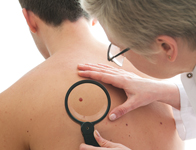DESPITE Australia being a world leader in public education and awareness campaigns about melanoma, Australians remain dangerously complacent about sun safety, says Cancer Council Queensland senior research fellow, Associate Professor Peter Baade.
Two in three Australians would be diagnosed with skin cancer by the time they reached age 70 years. More than 10 000 Australians were treated for melanoma each year, and more than 1200 Australians died from melanoma each year, Professor Baade said.
He told MJA InSight that US research on melanoma survival in young US men, which found they were 55% more likely to die of melanoma than age-matched women, was comparable to Australian studies which showed similar results. (1)
“Males of all ages in Queensland are 54% more likely to die from melanoma within 5 years of diagnosis than females”, Professor Baade said. (2)
Australian statistics showed the age-standardised mortality rate for melanoma among people aged 0–39 years was relatively low, but higher among males (0.6 deaths per 100 000 men) than females (0.4 deaths per 100 000 women). (3)
He cited public health campaigns, such as Slip, Slop, Slap, which began in the early 1980s, subsequent SunSmart campaigns, and the Cancer Institute of NSW’s January 2011 campaign featuring the true story of 26-year-old Wes Bonny, as evidence of Australia’s leading stance on public awareness about melanoma. (4)
“The high awareness of melanoma in the Australian community and among clinicians is in part responsible for the fact that the majority of melanomas in Australia are diagnosed at an early, curable stage”, he said.
“The Cancer Institute of NSW reported that the Wes Bonny Testimonial campaign achieved high believability (79%), recognition (70%) and was found to be attention-grabbing (54%).”
Professor Baade said that despite the high-profile campaigns, including the recent involvement of Australian cricket captain Michael Clarke as the face of the Cancer Council National Skin Cancer Action Week, complacency in young adult Australians was “definitely” a risk.
“The idea that ‘it won’t happen to me’ is prevalent across a range of health conditions and situations, and even more so among younger people”, he told MJA InSight.
“In Queensland specifically, according to the latest Self Reported Health Status report, only 5.9% of Queensland adults practised all five recommended sun-safety behaviours in summer. In winter, this dropped to 2.5% in 2012 — down from 3.6% in 2011.” (5)
He said complacency was a big danger across all ages “both in terms of failing to protect ourselves from the sun and failing to be familiar with our own skin, and [failing to] seek advice when something changes or looks suspicious”.
An editorial accompanying the US study said the results were so consistent with other studies that “they imply a fundamental biological difference in ‘male’ vs ‘female’ melanoma, at least for a significant fraction of patients”. (6)
“An obvious possibility could be distinctive exposure patterns to UV radiation”, the authors wrote.
They cited behavioural differences such as “women’s greater propensity to examine their own skin, their opportunities for receiving medical and preventive care, and the facileness with which they engage physicians in discussions about preventive care or request skin examinations within a routine visit to their primary care physician”.
1. JAMA Dermatol 2013; Online 26 June
2. Cancer Council Queensland Survey
3. AIHW 2012; Australian cancer incidence and mortality
4. Cancer Institute NSW 2011; Wes Bonny testimonial
5. Queensland Health 2012; Self reported health status
6. JAMA Dermatol 2013; Online 26 June

 more_vert
more_vert